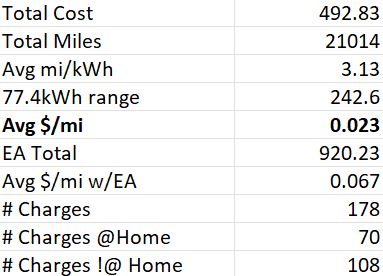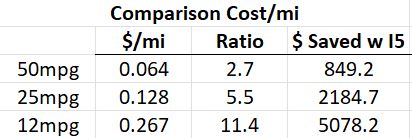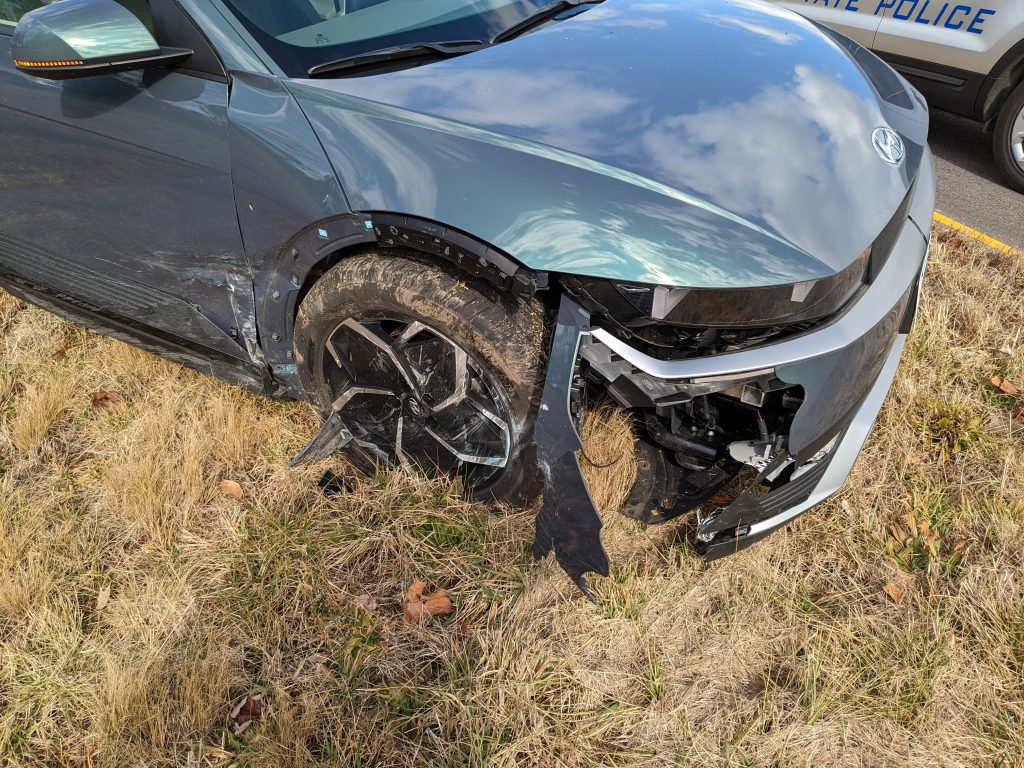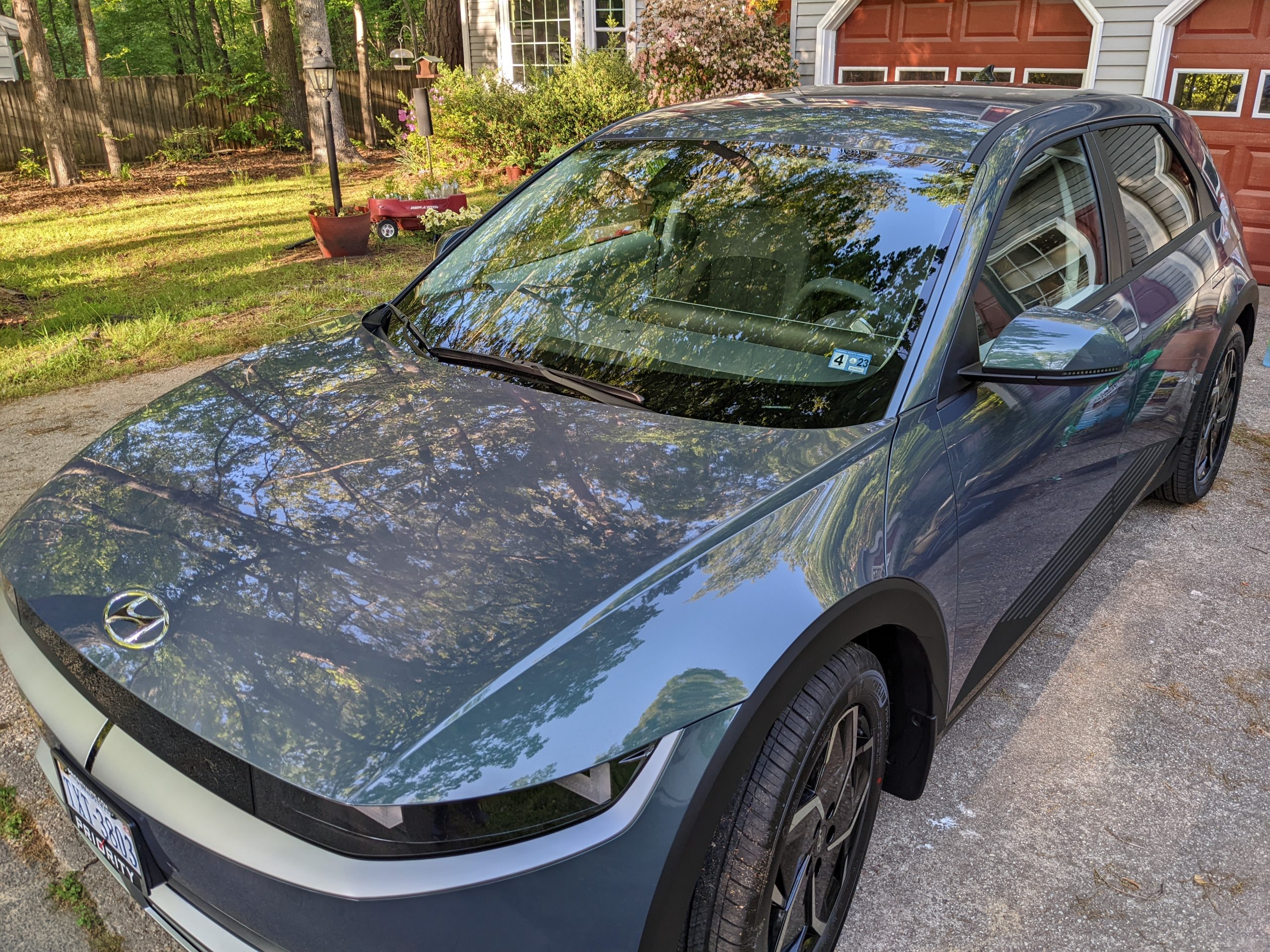I brought my 2022 Ioniq 5 SE AWD home on April 27, 2022. On the second anniversary of that purchase, this article will cover some of my adventures, my costs, and other long term thoughts.
I’ve written a few previous articles on my Ioniq 5:
- Buying my first EV
- My First Multi-State EV Roadtrip
- FAQ: Ioniq 5 Frequently Asked Questions answered
A Quick Recap summarizing the purchase and first long road trip
The Ioniq 5 SE is the base trim level for the car. I did upgrade to AWD (all-wheel drive) for a heat pump, a little better acceleration, and slippery road control at the cost of a slightly higher price and slightly lower range (more in previous article on the purchase.) Due to high demand, dealers were frequently charging additional dealer markup but the only extra cost that I paid for was $460 in dealer options including floor mats and mud guards to bring the sticker price to $49,205. Adding tax, tags, and the purchase and install of a home charging system and subtracting tax rebates made my total cost for the purchase $46,398.60. This is by far the most expensive car that I have ever bought.
Over two years, I have driven the car a little more than 20,000 miles. Most of this has been daily local driving, but I’ve also gone on a half dozen trips across the state requiring 3 charging stops for the round trip, a long trip to and around Pennsylvania, and a much longer 1600 mile round-trip from the Hampton Virginia area to Detroit which required 9 total charging stops averaging 20 minutes each. Click the link for a lot more detail on that epic adventure.
Charging Times and Costs
Being an engineer, I have tracked every charge of the car on an Excel spreadsheet stored on my Google Drive. That allows me to edit the same file from my phone if I am on a trip or on my computer when at home. In a few cases the values were estimated as free chargers at hotels, libraries, and parking garages don’t generally supply detailed reports and occasionally even high-end DC fast chargers have screen glitches. But, the vast majority of the data is exact and gave me enough information to estimate the few cases where I didn’t have numbers.
For each charging session, I recorded the date, the odometer reading, the battery start and end charge percentage, the time charging, the kWh of electricity charged, the price paid and the price if I didn’t have free charging.

The first number I want to point out is the 2.3 cents per mile fuel cost. I have paid a little under $500 for fuel to drive a little more than 20,000 miles!
Two caveats to that number. First, I pay an additional one cent per mile as a Virginia Road Use fee that takes the place of highway taxes paid with gas purchases. This is billed to my credit card monthly as part of the “Mileage Choice” program. The amount I pay annually is capped at the average payment made by a gasoline car driver and I have tended to come in a little under the max cap.
The second caveat is that my car came with a promotional two-years of free DC fast charging at Electrify America stations. These are one brand of the chargers that you use when you are on a road trip and want a 20 minute rather than 4-6 hour charge (like I do at home overnight). As you can see, if I had paid for those charges it would have cost an additional $920.23 or almost 200% more and brought my per mile cost to 6.7 cents. However, there were quite a number of times (early in my ownership) that I made a trip across town to use the “free” charging that I would not have if I were paying for it. So, I will not suddenly jump to the 6.7 cent rate once my free promo period ends. I will only pay the higher rate when I take the car on a long trip. I eventually figured out that the “free” local charging was costing me an hour of my time plus several dollars for a soda and candy bar snack. Paying to charge at home was actually cheaper and took substantially less time since I could plug it in and then do other things.
Some notes on charging times. At home, I typically charge the car from about 30% battery to 80% about once a week taking a little under 6 hours. I plug it in when I am done using the car in the evening and unplug it in the morning. It takes a lot less thought, time, and effort than stopping for gas. And this “fill up” costs less than $5. Hyundai recommends charging only to 80% for day to day in-town use, but charging to 100% is ok for road trips and they say should be done once a month at minimum.
On trips, using the fast chargers, my charging time is under 30 minutes 95% of the time with 20 minutes being more common. Hyundai advertises and I have frequently experienced an 18 minute charge taking the car from 10 to 80% charge. I think in the 108 charges that I have made not at home (which include free charging a parking garages, libraries, and hotels), I have had to wait 10 minutes for my turn at a charger twice. And in exactly one case, I had to wait 2 hours because I was in a remote location and two of the four charging “pumps” were having issues. This was annoying, but has happened to me once in two years. The site was at a WaWa, so I could get food and had restroom access. Everyone was patient, polite, took their turns correctly, and we all got charged and continued our trips.
Typical road trip charges of 20-30 minutes are great for making a rest room trip, buying a snack and drink, stretching your legs a little, and then returning to the road. These are needed at roughly 3 hour intervals which is when I’d be stopping for a restroom and gas station if I were driving a gas car. So, the additional time for the trips is minimal as I don’t have to stay with the car while it is charging like I would with filling a gas car. Note that this charging speed is on the fast end for current EV models; a few are faster but many other EVs will take 2-3 times as long to charge during a trip. Consider this if you are researching EVs.
Fuel Savings
Ignoring the caveats above, my spreadsheet also estimates the fuel cost savings for the 2.3 cent per mile versus several generic gas cars. I have assumed an average $3.20/gallon cost over the last two years, which is a ballpark guess with no hard data behind it. That generates the following chart:

So, for instance, if I was comparing my purchase to a 12mpg pickup truck that cost $5000 less, I have already paid for the difference with fuel savings. But, if I am comparing to a 50mpg Prius I will need to drive almost 123k miles to save $5000, twice that to save $10000, etc. For a more normal 25mpg sedan, I save $5000 at a little under 50k miles.

Other Savings and Costs
Electric vehicles are mechanically much simpler than gas vehicles. They generally require less maintenance. For instance, they don’t require oil changes. They do require small things like wiper blades, wiper fluid, and cabin air filters. Brake pads are replaced less often due to seeing less use but tires may not last as long and may be more expensive due to the weight of the cars. There is a scheduled battery coolant replacement at 40k miles that appears to cost about $350.
Car insurance and local property taxes on vehicles are mostly based on the value of the car modified by safety features that have been added to newer vehicles (EV or not). So, I am paying more for those than I would for a less expensive hybrid vehicle that I might have otherwise chosen.
So far, I have not had to pay for any maintenance beyond self-installed wiper blades, wiper fluid, and cabin air filter. I have had the tires rotated, several software upgrades, and state inspections for free. The only issue that I’ve had for a while was with charging at home cutting out when set to the full 11kw that the charger and car support. A software fix was installed that lowers the charging speed when the car thinks things are overheating. Now charging does not stop, but instead drops to 7kw and takes a little longer to complete. A minor, but livable, frustration.
All in all, it is hard to definitively say that I am saving or spending more money on this car than on the other models that I considered. I don’t think that any difference is very large.
Repair Experience
In January 2023, I was returning from a technical conference along a highway and had another car initially stop and then roll out in front of me. I hit the brakes and the horn and dodged. I ended up in the median with significant damage to the front, passenger, corner of the car. The airbags did not deploy.

I was not at fault and both I and the other driver were physically alright. The other driver had just done brake work on his 70s sportscar and something wasn’t done correctly so he was unable to avoid rolling out into the highway.
One of the concerns with buying the first model year of a new car is the availability of parts. I had heard stories of people waiting for months for what should be simple repairs. But, 40 days after the accident and about $16,000 (covered by the other driver’s insurance) in body work later, I had my car back, nearly as good as new. There is a new subtle noise steering at very low speed, but no visible damage.
The Future
Hyundai and most of the other major EV manufacturers have agreed to switch to the Tesla-style North American Charging Standard (NACS) port starting in 2025. Existing CCS equipped cars, like my Ioniq 5, will be able to use NACS chargers with an adapter. Hyundai has announced that they will be providing these adapters free to its customers. Third party adapters are also being announced; please read reviews before purchasing. Plans of non-Tesla charge providers to convert are also currently unclear.
I am waiting for more information on the switch and am unsure how it will impact me. I think it will be an improvement over the status quo for people who buy an EV in 2025 or later due to simplicity and more availability. For me, due to the limited amount of charging that I do away from home, I think the impact of the change will be fairly limited but hopefully positive.
Conclusions
I have really enjoyed owning and driving my Ioniq 5. Its sporty, has a fair bit of cargo room for trips, and the charging and maintenance has, for the most part, been easier than it would have been for a gas car.
Addendum
About a month after posting this retrospective, my car’s 12 volt battery started to fail. All of the Hyundai ICCU and other software updates had been performed. But the battery was dying. I ordered a new, hopefully better, battery and spent 15 minutes to install it. All has been great since then, but it has only been a few months. Hopefully, I will get more than two years out of this battery.
I chose an AGM type battery in the Group 47 size that fits in the car. I got this battery from Weize, which at the time of writing is not currently available from Amazon in the group 47 size. Please verify that you have selected the correct size before ordering and choose another brand if this one is not available. When installing the new battery, please be sure to open the fuse box beside the battery and pull the brightly colored and tagged yellow fuse up about 1/4 inch to disconnect the 12v from the car and insure that the system doesn’t try to recharge the 12v while you are changing it out.


Charging Behavior – More Data!
Some of the most common questions for most EV owners are about charging: how often, what does it cost, etc. Here is a different set of average results from my spreadsheet. Remember that two years of light-to-medium use of free EA fast charging plus free opportunistic charging at hotels, libraries, and parking garages has an effect on my cost numbers.

I typically charge to 80% for day-to-day use. I let my charge drop to the 20-30% range before I start being concerned that I don’t have enough range for an unplanned errand or two and decide to charge. I charge to 100% before a road trip plus once-a-month as implied on page 1-9 of my 2022 manual:

